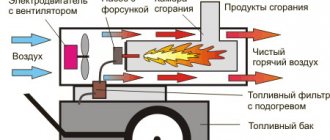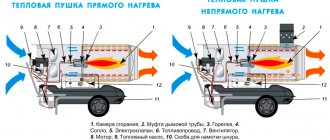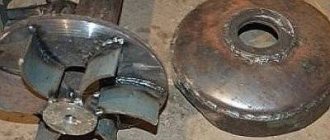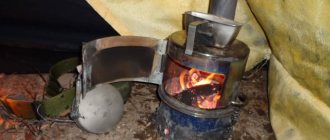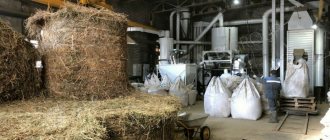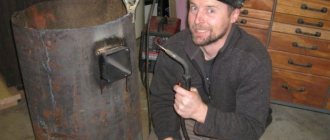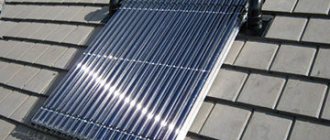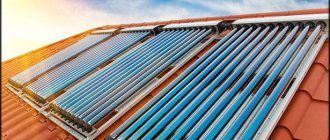One of the most pressing problems in winter is heating the premises. There is a lot of different equipment that is designed for this purpose. Nowadays there is a huge variety of heat guns on the market. They differ in price, size, and type of fuel used. You can make a gas gun with your own hands. In terms of technical indicators, it will not be inferior to factory analogues, and its cost will be much lower.
You can make a similar heat gun with your own hands
Scope of application and principle of operation
According to the principle of operation, factory-made and home-made gas heat guns are similar to conventional fans. But these devices pump air into the room. It gets inside the body of the unit and heats up there. Heating occurs using burners operating on various fuels or an electric heating element. Heat guns are used to solve a variety of problems. Application area:
- Production zones. Large rooms are heated.
- Agriculture. They are used when it is necessary to maintain the required microclimate (in greenhouses, greenhouses).
- Construction. It is used for accelerated drying of the treated surface, as well as for the installation of suspended ceilings.
- Life Heating of outbuildings, as well as residential premises during a lack of heating.
Read also: device of a gas heat gun for the garage.
When using, fire safety precautions must be observed. This is especially true when used near flammable materials.
Heat guns differ at least in design
Principle of operation
Electric heat guns operate on the principle of convective heat exchange. By means of a fan, cold air moves to the heating element and is then supplied to the premises, while its temperature is already noticeably higher. Many modern models have a built-in thermostat that automatically turns off the heating if the required temperature indicators have already been reached, and then turns it on when the air in the room cools down. Typically, such a thermostat is located at a certain distance from the device itself, so it shows the actual temperature inside the room.
Types of heat guns
Thermal heaters are divided according to the heating method and the type of fuel used in operation. They can also differ in purpose (domestic and industrial).
The heating process can occur in different ways . It depends on the type of design of the model. A direct-heating device has a fairly powerful fan that draws in air. Direct contact of the heating element with the air mass heats it and throws it through the nozzle.
Such devices cost relatively little, and their efficiency is quite high. But from an environmental point of view, devices with direct heating are considered bad. They emit all combustion products into the room, which can be dangerous for humans. It is advisable to provide forced ventilation at the place where the device is used.
In this video you will learn the specifics of a gas gun: The design of devices with indirect heating is more complex. It contains a heat exchanger that plays the role of a filter. It separates warm air and combustion products. A pipe runs from the device through which all harmful substances go out into the street.
Burners with indirect heating are more expensive, and their efficiency is lower than devices with direct air heating. But the demand for them is still high due to safe operation.
When choosing the type of heat gun, you need to consider the operating conditions . A device with direct heating is suitable for heating or drying large rooms where there are no crowds of people (warehouses, basements).
If a gun is needed in a production workshop or during the construction and renovation of residential premises, then it is better to choose models with indirect heating.
DIY super gun:
Key points to consider
Even if you have all the necessary knowledge and skills, you need to follow a few fairly simple rules:
- The body of the gun should not come into contact with the cylinder. This may cause it to overheat and explode.
- All gas supply pipe connections must be sealed.
- Do not ignite gas from burning paper or a lighter - this is very dangerous. To do this, you need to install a special remote ignition device.
- Cylinders must be filled using special equipment, which is available only to special services involved in filling such cylinders with gas.
- The power of the gun must be carefully read and not exceed what is necessary.
- Do not leave the unit running unattended.
Self-made units cannot ensure complete combustion of gas. This leads to the need for a device to remove combustion products to the street.
Such models of gas heaters provide in their design not direct heating of the air with an open flame, but through a heat exchanger.
Gas combustion, in this case, occurs in a closed combustion chamber, and heat is transferred to the body of the heat exchanger, which heats the air. Exhaust gases from the combustion chamber are discharged to the street through a pipe - a chimney.
This version of the gun is safer to use, and the power will be enough to heat even a large room.
If the body of the unit itself gets too hot, you can cover it with a heat-resistant heat insulator, which will make heating more efficient and prevent burns when touching the body.
Classification by fuel type
There are many manufacturers and models of heat guns. They differ in the type of fuel they use. Varieties:
- Electrical. The air mass is heated using electric heating elements. They are environmentally friendly, do not burn oxygen from the air and do not emit substances harmful to the body. The downside is the high cost of operation due to high energy consumption.
- Multi-fuel. Used hydraulic or motor oils are used for operation. Such devices are very cheap to operate, but they should not be used in crowded areas or where it is impossible to provide good ventilation.
- Mermen. The main design difference from other types is the equipment with an evaporator. Heating occurs due to a strong flow of steam. Most often, such units are used in agriculture to heat greenhouses and greenhouses, as well as to maintain the necessary microclimate.
- Infrared. Heating occurs due to infrared radiation. These are household heaters that can also be used to heat surfaces in open spaces.
- Gas. The air is heated due to the combustion of propane or methane. You can make a gas heat gun with your own hands. It is better to use ready-made drawings.
Heat guns are often divided into household and industrial. Industrial ones have increased power, size and, accordingly, cost when compared with household ones.
Heat gun for garage from gas heater:
How to choose a gas gun in a store and what to look for
When choosing a gas gun for domestic use, you should first pay attention to the following parameters:
- Power. It is measured in kW; sometimes manufacturers additionally indicate the volume of heated air per 1 hour of operation. In the first case, the formula is followed: 1 kW per 10 m2 – minimum. Secondly, it is necessary to calculate the total volume of the room planned for heating with a gun and divide the resulting figure by 2. This will give the minimum power of the gun, with which the room can be heated within 30 minutes of continuous operation of the heater. For example, the volume of air heated by a gun is 300 m3. Accordingly, it is optimally suited for a room with a volume of 150 m3 (volume and area should not be confused - these are completely different indicators).
- Connection type. This means with a closed or open burner. The first ones are more expensive and they are used for “emergency” heating of residential premises. It is not worth buying them for other purposes. Open ones are the best option for garages, sheds, warehouses and other non-residential premises.
- Presence of automatic arson. In principle, the function is not required. Moreover, piezoelectric elements fail quite quickly, but their presence increases the cost of the gun by almost 10–20%.
- Availability of additional functions. This means adjusting the fan speed, sensor system, thermostats, and so on. All of them help automate the operation of the gun, but manufacturers do not recommend leaving heaters of this type running without supervision. And the presence of those same sensors also increases the final cost of the device. If you need to save money, you can buy a gun without all these sensors.
- Power supply for fan. Available either from 220V or 12V DC. The last option is convenient because the gun can be used as a mobile gun, launching it even in the absence of a household electrical outlet. If such functionality is not needed, then it is better to take it with the simplest 220V motor. Even better - without brushes (such motors are very reliable and durable, but are quite expensive).
Operating principle of a gas gun
Table 1. Key parameters of gas guns that must be taken into account when purchasing.
| Power | Not less than 1 kW per 10 m 2 of heated room |
| Type of gas the gun operates on | Methane - for connection to the household gas network, propane - for cylinders. There are also “universal” guns, but they are expensive and often break down due to the complex technical design (there are 2 separate valves working at the same time) |
| Auto-arson | It is recommended to take one without automatic ignition - such models are cheaper, their starting is not dangerous |
| Availability of additional sensors | Not necessary. Most of them will not be used by anyone - tested in practice |
| Fan motor power supply | With support for connecting to 12V, buy if the heater will be used as a mobile one. In other cases - only 220V |
| Closed or open burner | Closed - for heating residential premises, open - for everyone else |
An option for using gas guns is for installing suspended ceilings. Under the influence of high temperature, PVC fabric easily stretches, there are no folds or dents left on it
Characteristic features of the devices
Gas guns are used both in industry and in everyday life, for example, when heating private houses or garages. Such devices are less mobile than electric ones, but more economical and have quite high power. The figure can reach up to 150 kW.
Natural gas is used as fuel, but liquefied gas can also be used. Such devices require an electrical connection. Electricity powers the fan, thermostat, and other necessary elements.
To operate a thermal gun, different gas modifications are used:
- Liquefied butane, propane.
- Gas supplied through pipelines.
High-power modifications are connected directly to the gas pipeline through special hoses. This allows the device to operate continuously. Typically, such units are made stationary, since their movement is quite difficult.
There are also several types of gas modification in a heat gun
Compact devices run on bottled gas. Some models provide a connection to a large cylinder via a hose, while others have a special compartment with gas. Also, most models have additional elements that ensure safety during operation of the device: case protection, flame level control, automatic shutdown system.
Rating of the best models
Among the best models of thermal gas guns, several brands can be noted.
Quattro Elementi QE-15G
The unit is small in size and can be used to heat only ventilated areas. Gained popularity among builders. Used for drying walls after plastering and simply heating the room. The unit runs on propane-butane. Can be connected to a standard electrical network.
One of the advantages is the absence of an unpleasant odor. Piezoelectric ignition. The body is made with high-quality thermal insulation. The heat gun is protected from corrosion by a special coating. Electrical components are also protected against dust and moisture. The productivity of the heat gun is 500 m³/h, fuel consumption is 1.2 kg/h. The design is lightweight - 5 kg.
Heat guns are designed to last a long time. They are made from high-quality elements and materials, but only if the necessary operating conditions are met can we talk about the durability of the product. Such equipment may be supplied with additional accessories. A thermostat with a cable will allow you to remotely control the unit
No matter what model of heat gas gun is used, it is strictly prohibited to use such equipment in rooms where the environment is highly corrosive.
It is unacceptable to install the gun in explosive, dusty areas or where there is increased biological activity.
A thermostat is a useful acquisition for those who want to regulate the operation of a heat gun without having to directly switch the mode. Thanks to this accessory, you can change the fan speed quickly and easily.
DLT-FA50P (15 KW)
This gas heat gun is ideal for heating production premises in the autumn. The design includes an emergency valve, thanks to which it was possible to increase the level of safety of the unit. As soon as the flame goes out or the pressure changes, the gas supply stops automatically.
The manufacturer used an electric element as ignition. To generate a spark, simply press the appropriate button. The unit is manufactured in South Korea and is sold with a hose and reducer.
"Instar" GTP 17010
A model with direct heating, which already indicates the impossibility of using a heat gun in a residential area. The unit is ideal for use in a car service center or warehouse. The manufacturer used only high-quality materials to produce the device, making the equipment durable.
"Rekanta" TGP-10000
Heat gun used in ventilated agricultural and industrial areas. The burner is equipped with piezoelectric ignition. The equipment operates on propane and butane. To operate the device, you must first connect it to a single-phase source, from which the power will be supplied. The fuel burns almost completely, making the unit highly efficient. A durable metal case protects the internal components from damage.
During operation of the heat gun, a low noise level is maintained.
Quattro Elementi QE-35GA
It is allowed to use the described heat gun in a room with people, but it must be well ventilated. Propane and butane are used as fuel. The fan is made of metal, its blades are activated after the unit is connected to the electrical network. The manufacturer carefully thought out the design of the heat gun and provided an adjustable tilt. This way you can easily direct the air flow in the desired direction.
There is a small empty space between the inner and outer casing, which is necessary to provide thermal insulation.
Required materials and tools
It is important to understand that homemade production of gas heat guns should only be carried out with proper qualifications and extensive experience in working with gas and tools. If you take on work unprepared, it can lead to irreversible consequences.
To make a gas gun you will need the following tool:
- Metal pipe. Fuel will be supplied through it to the main system.
- Bulgarian. It is better to use 125, as it is more convenient to work with.
- Sheet steel.
- Electric drill and metal drills.
- Steel tube with a diameter of 8 mm. It will be used to make a heat exchanger.
- Thick reinforcement for the stand on which the gun will be located.
- Fan power – from 12 W.
You can use a welding machine to speed up the process. You can also buy paint that is resistant to high temperatures in advance.
When creating this gun, do not forget about safety precautions
Making a drip heater
Most often, craftsmen use old oxygen and propane cylinders with a diameter of 220 and 300 mm, respectively, to assemble droppers. The former are preferable because of their powerful thick walls that can last a long time and not burn out. A pipe made of low-carbon steel (St 3-10) with a wall thickness of 5 mm or more is also suitable.
Select rolled metal for other parts according to the drawing of the furnace with top feed of waste into the combustion zone. The blower fan is a “snail” from a VAZ 2108 cabin heater or its Chinese equivalent, the fuel line is a stainless tube with a diameter of 8-10 mm.
- Make a fire bowl from a piece of pipe or take a ready-made steel container. It must be removed through the inspection hatch, so do not make the tray too large.
- Cut openings in the body for the chimney pipe and cleanout hatch. In the latter, make a frame and install the door (possibly bolted).
- Make an afterburner. Take your time to drill all the holes indicated on the drawing; do the bottom 2 rows first. You will complete the rest while setting up the oven.
- Weld a cover and an air duct with a flange for mounting the fan to the afterburner. Attach the fuel supply device as shown in the photo.
- Assemble the heating unit and connect it to the chimney.
The afterburner in the photo is close-up - side and end views
To regulate the heating power, it is necessary to provide control of the fan speed and a device for dosing the fuel supply (as a rule, an automatic drinker with a jet break is used). According to reviews from craftsmen on a popular forum where heat extraction issues are discussed, fuel consumption in the furnace can be monitored visually. The trend is this: if the oil flows in drops at the break in the stream, then less than 1 liter per hour burns, and when a thin stream flows, more than 1 liter per hour.
Different designs of dropper bowls
After ignition and warming up of the heater, it is necessary to set the optimal operating mode. The procedure is carried out according to the same scheme as with the miracle stove: you need to achieve the most transparent smoke from the chimney by drilling additional holes in the afterburner. The ideal flame color is blue, normal is yellow, and reddish is unsatisfactory. In the latter case, low heat transfer, high consumption and soot formation are observed. For details about the design and assembly of the furnace, see the video:
Step-by-step instruction
The first step is to make the body. You can use sheet steel 3-4 mm thick or a regular pipe. The sheet needs to be given the required parameters, and then it needs to be rolled into a pipe. The edges are secured with bolts or a special connecting lock.
After this, the pipe that is used to supply gas is sawn. This is necessary so that later it will be possible to weld the next element to it.
Homemade gas gun:
Now it is necessary to increase the diameter of the hole, which is intended for gas to enter the system. You need to bring it to 5 mm.
Then the heat exchanger . Take a metal pipe with a diameter of 80 mm. The end must be welded to the burner wall and a hole must be drilled. The burner extension passes through this element.
To allow the heated air to escape, a hole must be made in the heat exchanger housing. Then weld a tube with a diameter of 8 cm in that place.
Then a fan is installed to circulate the hot air. It is also necessary to provide for the supply of electricity. You can connect it to the network or battery.
Finally, you need to drill holes to ignite the gas. It is also necessary to provide a structure on which the heat gun will be located. You can use a ready-made stand or weld it from reinforcement.
Heat gun. with your own hands:
Trial run
To use the gun you need to perform some procedures.
- We light the lighter by bringing it to the fuel ignition hole.
- Open the valve so that gas begins to flow.
- When the gas lights up, put the lighter back.
- Turn on the fan.
If we briefly consider the manufacturing technology of this kind of heat gun, it looks like this:
- We attach a metal extension disk to the burner;
- we extend the pipe necessary for gas supply to the device;
- we install iron plates necessary to improve heat transfer;
- install the clamp on one side of the extension, after which you need to secure the heat exchanger itself;
- We assemble the entire heating device;
- we make holes in the heat exchanger so that hot air can escape through them;
- We weld a metal ring to the second end of the pipe;
- We install a switch on the heat exchanger that will turn the fan on/off;
- fan assembly itself.
Do not forget that a DIY gas gun also needs a housing. This body, as you know, most closely resembles an ordinary pipe, so we can easily make it ourselves. To do this, take a sheet of steel that is not too thick, cut it to give it the required size, and roll it into a pipe.
In order to connect the edges of the sheet together, you can resort to the connecting lock method. If for one reason or another you cannot do this, then use regular fastening bolts.
Well, so we looked at the features, operating principle and manufacturing technology of such a device as a gas heat gun. This device is very popular due to its efficiency and the ability to heat large areas in record time. You can do it yourself, just have a list of necessary tools, materials, and a little patience.
Safety precautions
This device is a fire hazard, so all safety rules must be followed. Requirements for operating the device:
- A homemade gas gun cannot be left unattended. Factory ones often have an automatic safety system that shuts off the gas supply in emergencies.
- Do not use the devices in places where flammable objects and substances are located.
- Good ventilation of the room must be ensured.
- The open air heating device should be placed only on flat surfaces so that the position is stable.
- Cannot be used outdoors during rainfall.
Before using the device, make sure that the outlet is grounded. The ends of the gun can be covered with a metal mesh to disperse the air flow.
How to make it yourself
Gas guns began to be actively used in our country relatively recently. As already mentioned, this device is excellent for heating various rooms. It is especially popular for heating buildings without gas supply. For example, country houses, country houses, garages, etc.
The gas gun has the following advantages:
- mobility;
- safety in operation;
- small in size;
- high efficiency;
- ease of installation and dismantling;
- good power;
- ability to regulate temperature.
The popularity of a gas gun is significantly influenced by its objective and reasonable cost. Moreover, making it yourself will be much cheaper than buying a ready-made factory product.
About useful modifications of an iron stove
There are several recommendations on how to make the above design even better. The first step is to strengthen the junction of the chimney pipe to the top slab, since this is the place that burns out most often. The reason is not only the high temperature, but also the load exerted on the weld by the chimney pipe. Typically, garage owners do not bother with separate mounting of the chimney and its entire weight rests on the top panel of the stove.
A wood-burning stove with 2 smoke circuits cannot boast of the size of the firebox, and therefore the duration of combustion. On the other hand, homemade long-burning stoves like “Bubafonya” are not the best option for a garage. They require a chimney at least 4 m high with good draft, which is not always feasible.
The firebox of a two-pass stove can be increased by arbitrarily changing its height or adding 10 cm to the width of the body. The good thing about homemade heaters is that the garage owner can change their size depending on the free space of the room.
The heat transfer of a wood-burning stove can be improved if several vertical ribs are welded to the side walls, as shown in the photo below. A 4 mm thick strip or the same corner is used, thereby increasing the heat exchange area and increasing the efficiency of the heater.
The photo shows a cast iron stove with convection fins and a hob. A similar structure can be welded from steel
Advice. A potbelly stove can be adapted for cooking or heating food by cutting a round hole in the top panel for the burner.
Appearance
This takes into account such nuances as aesthetic appeal, achieved through the use of two main shapes - rectangular and cylindrical, as well as high-quality paint and the dimensions of the unit. If the device is planned to be used exclusively for domestic purposes in a small room, then a compact heater weighing 5-10 kilograms with dimensions ranging from 25-50 centimeters is the best option. If there is a need to purchase a unit of greater power, then you should be prepared to transport equipment whose weight will be 50-150 kilograms with dimensions of 1-3 meters for each parameter.
Other characteristics
We have analyzed the main parameters: the rest do not seem so important. But if you want to approach your choice with full responsibility, then study them too.
Air flow
Shows how much air mass the device creates per hour. This characterizes the heating speed and depends on the fan.
Bandwidth should be looked at in conjunction with power. If the flow rate is high and the heating capacity is low, the outlet stream will be barely warm. There is no sense in such equipment.
This option is not available for infrared models.
Dimensions
Compact samples have low productivity. Be prepared to deal with bulkiness if you require a high-power unit. In general, weight ranges from 1 to 1500 kg.
Electric guns weigh 3-70 kg, and gas guns from 3 to 700 kg. The range of mass of liquid fuel specimens is enormous: from a modest 1 kg to 1.5 tons.
Shape and material
The body can be in the shape of a pipe or a rectangle. The first one resembles a real military weapon with its elongated cylindrical shape. It is capable of producing higher temperatures than its competitor. At the same time, rectangular devices provide more uniform heat distribution due to the increased dispersion zone.
All structures are made of metal. This is due to the danger of melting the plastic. In household models there are plastic inserts, for example, handles and switches. As a rule, they are hidden in such a way as to prevent them from becoming overheated.
Functions
Heat guns do not differ in their variety of functions. These are already quite expensive products and there is no point in complicating them with additional bells and whistles.
Increased attention is paid to ensuring safety. The devices are equipped with a switch-off option when tipping over.
Liquid fuel and gas facilities are equipped with flame control: if it goes out, the fuel supply is stopped.
The thermostat helps control the heating level. As soon as the room temperature reaches the set value, the element stops working. Also, shutdown occurs if internal parts reach critical values. If you plan to leave the device unattended, then definitely buy a device with a thermostat.
Ventilation without heating allows you to mix the air in the room. And in hot weather, the device will replace your fan.
Diesel options
Malfunctions of a diesel heat gun include the following important points:
- Fuel is supplied to the combustion chamber intermittently. The appearance of this defect is primarily associated with contamination of the fuel tank and its supply system. In this case, it is recommended to drain the fuel from the tank and rinse thoroughly. Then you need to bleed the entire fuel system.
- The fuel mixture does not ignite. This failure is primarily due to defects in the spark plug. To eliminate the malfunction, it is necessary to remove the spark plug, clean it mechanically, and also adjust the gap between the electrodes of this ignition element.
- The heat gun began to work intermittently. This type of malfunction is associated with a clogged air filter. In such a situation, you need to install a new filter.
- The heat exchanger does not heat up well due to the small flame in the combustion chamber. This defect is due to the fact that the nozzle is very dirty. Cleaning in this case occurs non-mechanically. In other words, the nozzle is thoroughly washed and then purged with a compressor.
- During operation, the heat gun overheats greatly. This malfunction occurred because the thermostat failed. To eliminate the defect, you need to clean all thermostat elements or, if necessary, replace them with new ones.
In conclusion, we would like to wish you that your heat gun never breaks down, and if such a nuisance does happen, then following our recommendations, you can easily identify all the defects and safely carry out the repairs yourself.
Watch the video in which an experienced user clearly demonstrates the process of repairing a gas heat gun with his own hands:
